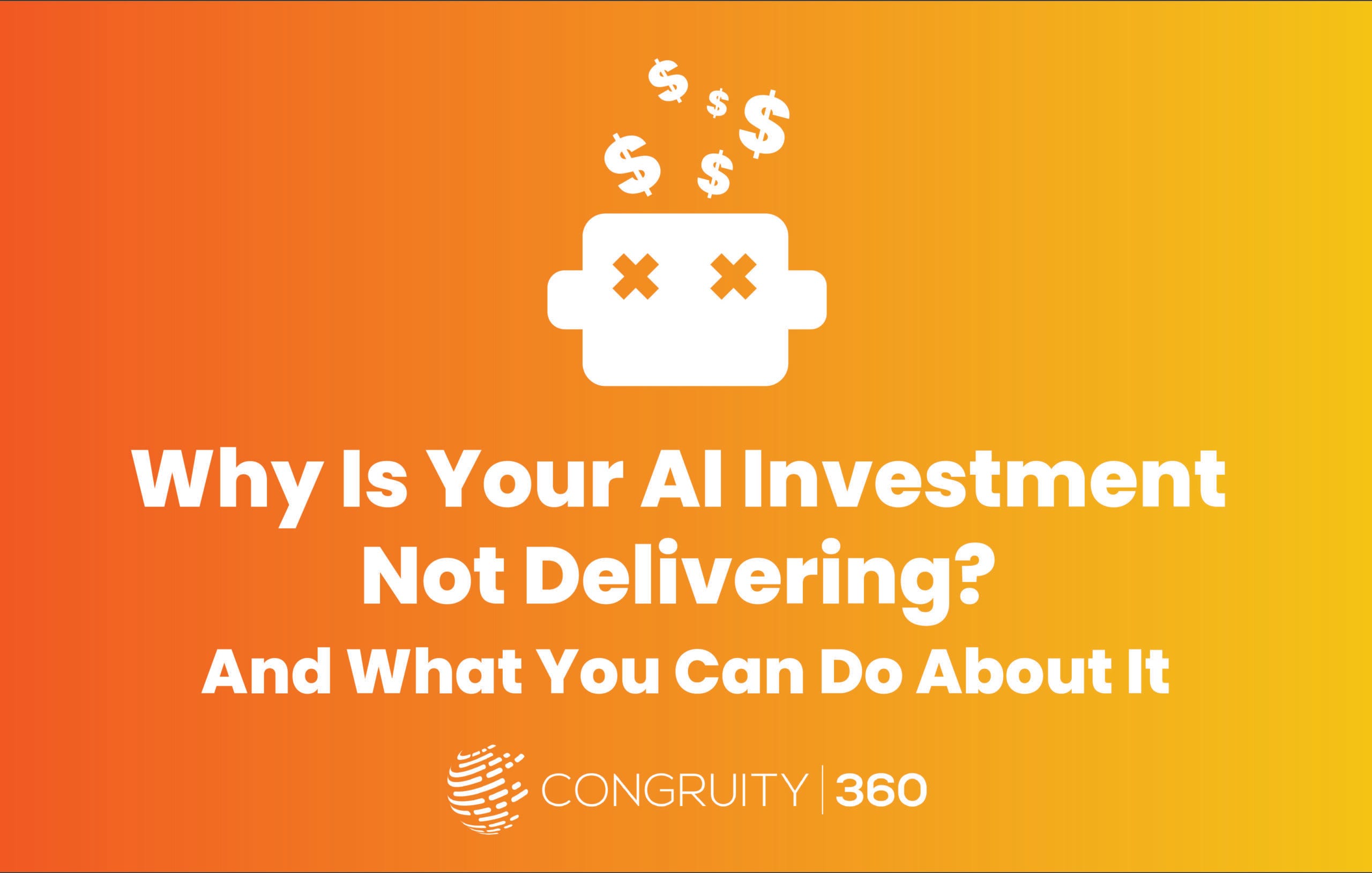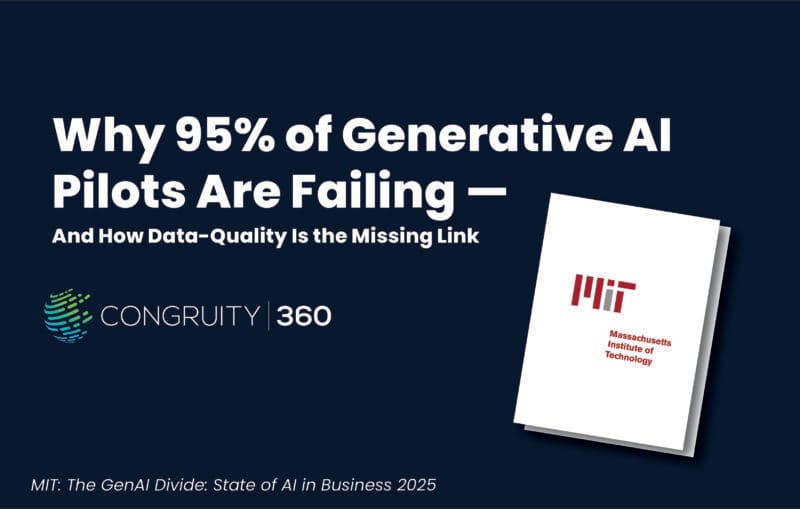Many organizations entered the AI era with high hopes. Tools like generative AI, predictive analytics, and advanced automation promised dramatic productivity gains, cost reductions, and new revenue streams. But several recent industry reports suggest that for many companies, the expected returns are simply not showing up — especially at enterprise scale.
For those of us in charge of data and information functions, this moment offers a critical opportunity: to reassess where our AI efforts are falling short and redirect toward what actually works.
The Reality Check: What the Data Says
• ROI remains elusive
A recent article from CIO reports that while many firms engaged in AI experimentation, they “acknowledge that the initial surge of use cases … had minimal impact on business transformation — and more importantly, the bottom line.” (CIO)
“Everyone wants to show the next-generation, interesting use cases, but when it comes to AI at scale … you’ve got to solve for the core, what I call, boring problems – not those that are tangential to the business.” (CIO)
• Large portion of projects may fail or be abandoned
Gartner predicts that at least 30% of generative AI (GenAI) projects will be abandoned after proof of concept by end of 2025 — largely due to poor data quality, lack of business value and escalating deployment costs. (Gartner)
Even more striking: research suggests up to 95% of enterprise AI initiatives deliver zero ROI in terms of measurable financial impact. (gcom.pdodev.aws.gartner.com)
• Value remains vague and un-measured
Another Gartner survey found that “nearly half of all AI leaders” struggle to estimate or demonstrate business value from AI technologies. (CIO)
This disconnect between investment and outcome is a major barrier — especially for the data/info functions tasked with proving value.
5 Reasons Why So Many AI Initiatives Are Underperforming
For data/information leaders, the challenge often lies less with the technology and more with the surrounding organisational, process, data and governance ecosystem. Here are the key reasons:
1. Lack of clear business use-cases
Too often AI is adopted because it’s “innovative” or “cool” rather than tied to a specific business outcome. As the CIO article states: many organisations are chasing the sizzle, not the steak. (CIO)
Without a clear articulation of how AI delivers value (e.g., cost reduction, revenue uplift, risk mitigation) it’s hard to measure and drive it.
2. Metrics and governance gaps
Even when pilots are successful, scaling them matters. Organisations that have succeeded emphasise early metrics, governance, change management and alignment across business and IT. (CIO)
If you don’t define success criteria before you deploy, you may never know whether you are winning.
3. Data & integration complexity
Many AI initiatives underestimate the cost/time required to integrate models with existing systems, clean and curate data, ensure reuse, and maintain the solution. Gartner pinpoints data quality, risk controls and cost overruns as key reasons for project abandonment. (THE Journal)
For those leading data and information, this is squarely in your domain: if the data isn’t ready and the integration isn’t smooth, the AI won’t perform as hoped.
4. Skills, change management and adoption
Technology is only part of the equation. Employees must adopt new workflows, understand what the AI does (and doesn’t), trust it, and change behaviours accordingly. The CIO piece mentions that individual productivity gains are real, but enterprise-scale transformation is still rare. (CIO)
If end users don’t use the tools, or use them in unproductive ways, the ROI won’t show.
5. Escalating costs and unrealistic expectations
The hype cycle has pushed many organisations to invest early, but many still struggle to scale cost-effectively. Gartner warns of projects being cancelled because the cost-benefit equation simply doesn’t compute. (THE Journal)
For data/information teams, this means tighter budgeting and more rigorous business-case development.
What Should Data & Information Leaders Do?
If you’re charged with making AI investments pay off, here’s a practical roadmap:
Focus on value-driven use-cases
Work on identifying specific business problems where AI can realistically deliver measurable impact (e.g., reducing claims processing time, improving customer retention by X %, automating low-value manual tasks).
Prioritize use-cases that:
- Have clean, available data already in-house
- Are well-understood by business stakeholders
- Have clear metrics and KPIs (both cost and revenue side)
Avoid the temptation of “shiny new tech” projects without clear alignment to your core strategy.
Define metrics early and embed them in your governance
Establish success criteria before you build.
- What does “success” look like (e.g., % reduction in manual effort, % uplift in revenue, cost savings of $X, time to value of months)?
- Build governance that spans data, analytics, IT, business operations, change management. The CIO piece calls it the “three-legged stool”: governance, business user group, and build practices. (CIO)
- Regularly measure and report on outcomes, not just outputs (number of models built, users onboarded) but tangible business impact.
Validate your data and integration readiness
- Conduct a data readiness audit: Are the relevant data sets available, clean, integrated, high-quality, and governed?
- Check integration points: will the model outputs actually feed into business processes and systems in a scalable way, or are they “manual one-off” decisions?
- Understand the total cost of ownership. From model development through production, monitoring, and maintenance. Remember Gartner’s warning about cost escalations. (prwire.com.au)
Drive organizational adoption and change
- Engage business stakeholders early. Ensure they understand the AI’s role and are willing and able to change behaviours accordingly.
- Provide training, communicate benefits, and build trust in the tool. If the workforce doesn’t believe in it, it won’t be used. The CIO article highlights that many early gains were individual productivity, not enterprise transformation. (CIO)
- Monitor usage and real-world behaviour: Are people using it? Are they achieving the benefit? If not, investigate why.
Scale wisely and monitor for “pilot-itis”
Many organisations stall at the pilot phase. Gartner predicts 30%+ generative AI projects will be abandoned post-pilot. (Gartner)
- Use pilots as a learning mechanism, not as an end-state. Document what works/doesn’t, then scale the successful ones with repeatable processes, governance, metrics, and a business case for expansion.
- Avoid spreading too many pilots concurrently without clear plans for scaling, resourcing and governance—this can drain resources and produce little impact.
The Road Forward to AI ROI
For data and information leaders, the current AI ROI gap is a technical, strategic, operational, and organizational failure. You hold a key role in closing that gap: by aligning AI investments with business value, by ensuring data readiness and integration, by embedding metrics and governance, and by driving adoption. The hype may have raced ahead of the results. But with the right disciplined approach, your organization can move from experimentation to value realisation.Looking to make the most of your AI investments? Start at the source of your project: the data.





